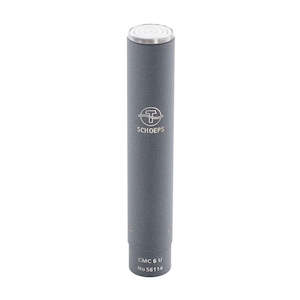Schoeps Mikrofone CMC 6 MICROPHONE AMPLIFIER

The CMC 6 is our most popular amplifier.
Its electrical properties have set new standards in terms of low distortion levels and common mode rejection (i.e. suppression of interference induced in the microphone cable). DESCRIPTION
flat frequency response
very low harmonic distortion and noise
balanced, low-impedance output
high suppression of interference on the microphone cable
excellent protection against high-frequency radio interference with "RFI Shield"
frequency-independent impedance
signal transmission possible over very long cables
reliable operation even with weak phantom power
symmetrical, transformer- and capacitor-free output stage with a class-A amplifier
above 20 kHz, the signal is attenuated for protection against interference in the ultrasonic range, e.g. through the ultrasonic autofocus of a film camera
The capsules of condenser microphones can't be connected directly to microphone cables or inputs; a microphone amplifier is required in between. Thus a complete microphone of the Colette series comprises any of the twenty available types of capsules combined with an amplifier. The CMC 6 U is designed for standard 48- and 12-Volt phantom powering. Its circuitry recognizes the supply voltage and adjusts itself automatically. Its performance characteristics remain essentially the same either way; mainly, the difference is that the current drawn at 12 Volts is greater than at 48 Volts. However, the 12-Volt mode consumes less power and might be preferred for battery-powered recording.
The microphone amplifier is responsible for providing the necessary electric charge to the capsule, without which it would be unable to generate a signal. Since the capsule's output signal is very weak (Hi-Z), it must be amplified. In order for the microphone's output to cleanly reach the next stage in the signal chain, it must undergo balancing and impedance matching before transmission. The CMC 6 incorporates a balanced, direct-coupled class-A amplifier, yielding a low output impedance, high RF shielding, and minimal distortion. TECHNICAL SPECIFICATIONS
Maximum sound pressure level (THD< 0.5 %) - with MK 4: 131 dB-SPL (P48, P12)
Frequency range - 20 Hz - 20 kHz
Sensitivity - see corresponding capsule
Maximum output voltage - 1 V (0 dBV) with 1 kΩ load
Low cut filter - 20 Hz, 12 dB/oct.
Minimum recommended load impedance - 1 kΩ
Output impedance - 42 Ω
Maximum cable length - >400 m / ~1300ft
SCHOEPS RFI Shield - Yes
Powering standard / Valid range - P48 / 20-52 V
P12 / 10-13 V
Current consumption - 4 mA (P48)
8 mA (P12)
Common mode rejection ratio (at 1 kHz) - >55 dB
Output - XLR-3M, analog, 1 channel
Length - 116 mm / ~4,5"
Diameter - 20 mm / ~0,8"
Weight - 60 g / 2,1 oz
Surface finish - matte gray
custom color:
nickel, chromagreen & OPTIONS
No. 191102 custom color: nickel, chromagreen, other custom colors on request
No. 191201 custom engraving
Apart from the standard CMC 6 version, Special versions of the CMC 6 U are available.
CMC 6 U linear
The CMC 6 U microphone amplifier normally has a gradual rolloff in response below 20 Hz to guard against infrasonic disturbances from various sources such as air movement and vibration. However, when using pressure (omnidirectional) transducers, particularly with digital recording, it can be desirable to pick up frequencies below 20 Hz without attenuation. The special technology of the CMC 6 U linear microphone amplifiers makes this possible; on request we can deliver microphone amplifiers with response that is flat to as low as 10 Hz. Caution must be advised with respect to infrasonics, however. Since pressure transducers can pick up very low frequencies, ventilation systems in large spaces (churches, concert halls) or traffic rumble can create a problem. With pressure gradient transducers the risk is even greater. They are far less sensitive to very low frequency sound, but respond much more strongly to low-frequency mechanical stimuli such as air currents and solid-borne noise. Such signals may be below the audible range of frequencies, but they can overload electronic circuitry and produce severe distortion, particularly in transformer-coupled circuitry.
CMC 6 U 5 dB
The sensitivity of a microphone using this t
- Store:
- Oceania Audio Sales
- Price:
- $1,395
